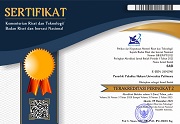Egalitarianism: Consciousness-Raising In Women’s Position In The Islamic Family
 )
)
(1) Faculty of Law Trisakti University, Jakarta, Indonesia

 Corresponding Author
Corresponding Author
Abstract
Introduction: The Muslim community in the world, including in Indonesia, perceives Islamic family law as very patriarchal. This is because in the discussion related to Islamic family law, it only refers to Al QS. AN-Nisa [4]: 34,which translates women's subordination from men..
Purposes of the Research: The purpose of writing this article is to describe a different side of Islamic family law which is always narrated by gender bias by the community, including the Muslim community itself, both in interpretation and even in its implementation carried out in a patriarchal manner. In fact, Al QS. Al-Hujuraat [49]: 13 implies that the rights and obligations of women and men on this earth are purely egalitarian.
Methods of the Research: Normative research with the consciousness raising method is in the form of a communication approach related to the position of women in Muslim families, with a communication approach in Muslim communities related to critical awareness to add knowledge of actualization of Muslim communities in Islamic family law which actually does not burden women.
Results of the Research: That the excess of men over women must be interpreted as that men are responsible for the maintenance and/or regulation of household affairs, not as rulers, supervisors or superiors of women. So it can be concluded that the concept of a man being the head of the family and a woman being a housewife as conceptualized by Article 31 of the Marriage Law and Article 79 of the KHI is no longer relevant at this time considering that based on the experience of women themselves and data showing an increase in the number of women family heads and women filing for divorce from year to year. As well as the fact that the wife helps her husband to prosper the family and even has to double burden because of it, must also be aware of his independence and not feel isolated because there are economic rights that they must obtain according to the efforts they have done as QS anNisa: 32.
Keywords
DOI
10.47268/sasi.v28i3.1021
Published
2022-10-13
How To Cite
@article{SASI1021,
author = {Wahyuni Wulandari},
title = {Egalitarianism: Consciousness-Raising In Women’s Position In The Islamic Family},
journal = {SASI},
volume = {28},
number = {3},
year = {2022},
keywords = {Egalitarianism; Consciousness Raising; Women; Islamic Family},
abstract = {Introduction: The Muslim community in the world, including in Indonesia, perceives Islamic family law as very patriarchal. This is because in the discussion related to Islamic family law, it only refers to Al QS. AN-Nisa [4]: 34,which translates women's subordination from men..Purposes of the Research: The purpose of writing this article is to describe a different side of Islamic family law which is always narrated by gender bias by the community, including the Muslim community itself, both in interpretation and even in its implementation carried out in a patriarchal manner. In fact, Al QS. Al-Hujuraat [49]: 13 implies that the rights and obligations of women and men on this earth are purely egalitarian.Methods of the Research: Normative research with the consciousness raising method is in the form of a communication approach related to the position of women in Muslim families, with a communication approach in Muslim communities related to critical awareness to add knowledge of actualization of Muslim communities in Islamic family law which actually does not burden women.Results of the Research: That the excess of men over women must be interpreted as that men are responsible for the maintenance and/or regulation of household affairs, not as rulers, supervisors or superiors of women. So it can be concluded that the concept of a man being the head of the family and a woman being a housewife as conceptualized by Article 31 of the Marriage Law and Article 79 of the KHI is no longer relevant at this time considering that based on the experience of women themselves and data showing an increase in the number of women family heads and women filing for divorce from year to year. As well as the fact that the wife helps her husband to prosper the family and even has to double burden because of it, must also be aware of his independence and not feel isolated because there are economic rights that they must obtain according to the efforts they have done as QS anNisa: 32.},
issn = {2614-2961}, pages = {447--457} doi = {10.47268/sasi.v28i3.1021},
url = {https://fhukum.unpatti.ac.id/jurnal/sasi/article/view/1021}
}
Journal Article
Alamanda, Septia;, and Akmal. “Penerapan Hukum Waris Islam Dalam Pembagian Harta Warisan Di Nagari Ujung Gading” 4, no. 4 (2021). https://doi.org/10.24036/jce.v4i4.623.
Anwar, Hilwa. “Orientasi Peran Egaliter, Keseimbangan Kerja-Keluarga Dan Kepuasan Keluarga Pada Perempuan Yang Berperan Ganda.” Jurnal Psikologi TALENTA 1, no. 1 (2015): 55.
Asliah Zainal. “Egalitarian Laki-Laki Dan Perempuan Dalam Keluarga Islam; Antara Idealitas Dan Realitas” (n.d.): 1–20.
Dedi, Syarial. “Kaji Ulang Pendapat Feminis Dengan Metode Ta ’ Wīl” (2018): 1–13.
Ipandang, Ipandang. “Islamic Law and Gender: The Collapse of The Oligarchical-Patriarchal Culture in The Konawe Region of Southeast Sulawesi.” Islam Realitas: Journal of Islamic & Social Studies 6, no. 1 (2020): 1–13.
Nurmila, Nina. “Pemanahanan Agama Dan Pembentukan Budaya,” no. 105 (n.d.): 1–16.
Rogers, Ann E. “Feminist Consciousness-Raising in the 1970s and 1980s: West Yorkshire Women’s Groups and Their Impact on Women’s Lives.” School of Sociology and Social Policy. UK: University of Leeds, 2010.
Sakina, Ade Irma, and Dessy Hasanah Siti A. “Menyoroti Budaya Patriarki Di Indonesia.” Share : Social Work Journal 7, no. 1 (2017): 71.
Tarigan, Azhari Akmal. “Pelaksanaan Hukum Waris Pada Masyarakat Karo Muslim Di Kabupaten Karo.” IAIN Sumatera Utara Medan, 2010.
Valentina, Tengku Rika, and Roni Ekha Putera. “Posisi Perempuan Etnis Minangkabau Dalam Dunia Patriarki Di Sumatera Barat Dalam Perspektif Agama , Keluarga Dan Budaya” VI, no. 2 (2007): 1–19.
Wijanarko, Wijanarko, Sarwititi Sarwoprasodjo, and Parlaungan Adil Rangkuti. “Communication of Critical Consciousness in Peasant Movement.” Makara Human Behavior Studies in Asia 18, no. 1 (2014): 1.
Book
Barlas, Asma” Cara Quran Membebaskan Peremuan” terjemahan dari "Believing Women" in Islam: Unreading Patriarchal Interpretations of the Quran. Oxford Universiry Press, London, 2003, diterjemahkan oleh R. Cecep Lukman Yasin , PT Serambi ilmu Semesta. 2005
Engineer, Asghar Ali. “The Rights of Women in Islam”. London: C. Hurst & Co., 1992.
Fatima Mernissi , and Riffat Hassan. Setara Dihadapan Allah. Yogyakarta: LSPPA-Yayasan Prakarsa, 1995.
Fakih, Mansour”Analisis Gender & Transformasi Sosial”. Yogyakarta: Pustaka Pelajar. 1996
Kelly, Christopher J. “Consciousness Raising.” Encyclopedia of Gender and Society. Edited by Jodi O’Brien. SAGE Publication, Inc, 2009.
Mernissi, Fatima and Riffat Hassan. “Setara Dihadapan Allah”. Yogyakarta: LSPPA-Yayasan Prakarsa, 1995
Rato, Dominikus. Hukum Perkawinan Dan Waris Adat (Sistem Kekerabatan, Bentuk Perkawinan Dan Pola Pewarisan Adat Di Indonesia). Surabaya: Laksbang Yustitia Surabaya, 2011.
Shihab, M. Quraish. “Perempuan.” 3rd ed. Jakarta: Lentera Hati, 2006
Wadud, Amina. Qur’an and Woman: Reading the Sacred Text from Woman’s Perspective. Oxford: Oxford University Press, 1999.
Cited-By:
1. Maqāṣidī's Approach to Qiwāmah and Nafaqah
Abdurrohman Awalul, Putri Mawariza, Jefry Ardian Syah , Nuranisah Nuranisah
al Hairy | Journal of Islamic Law vol: 1 issue: 2 first page: 161 year: 2025
Type: Journal [View Source]
| Dublin Core | PKP Metadata Items | Metadata for this Document | |
| 1. | Title | Title of document | Egalitarianism: Consciousness-Raising In Women’s Position In The Islamic Family |
| 2. | Creator | Author's name, affiliation, country |
Wahyuni Retno Wulandari; Faculty of Law Trisakti University, Jakarta; Indonesia  |
| 3. | Subject | Discipline(s) | |
| 3. | Subject | Keyword(s) | Egalitarianism; Consciousness Raising; Women; Islamic Family |
| 4. | Description | Abstract | Introduction: The Muslim community in the world, including in Indonesia, perceives Islamic family law as very patriarchal. This is because in the discussion related to Islamic family law, it only refers to Al QS. AN-Nisa [4]: 34,which translates women's subordination from men..Purposes of the Research: The purpose of writing this article is to describe a different side of Islamic family law which is always narrated by gender bias by the community, including the Muslim community itself, both in interpretation and even in its implementation carried out in a patriarchal manner. In fact, Al QS. Al-Hujuraat [49]: 13 implies that the rights and obligations of women and men on this earth are purely egalitarian.Methods of the Research: Normative research with the consciousness raising method is in the form of a communication approach related to the position of women in Muslim families, with a communication approach in Muslim communities related to critical awareness to add knowledge of actualization of Muslim communities in Islamic family law which actually does not burden women.Results of the Research: That the excess of men over women must be interpreted as that men are responsible for the maintenance and/or regulation of household affairs, not as rulers, supervisors or superiors of women. So it can be concluded that the concept of a man being the head of the family and a woman being a housewife as conceptualized by Article 31 of the Marriage Law and Article 79 of the KHI is no longer relevant at this time considering that based on the experience of women themselves and data showing an increase in the number of women family heads and women filing for divorce from year to year. As well as the fact that the wife helps her husband to prosper the family and even has to double burden because of it, must also be aware of his independence and not feel isolated because there are economic rights that they must obtain according to the efforts they have done as QS anNisa: 32. |
| 5. | Publisher | Organizing agency, location | Faculty of Law, Universitas Pattimura |
| 6. | Contributor | Sponsor(s) | Faculty of Law Trisakti University, Jakarta |
| 7. | Date | (YYYY-MM-DD) | 2022-10-13 |
| 8. | Type | Status & genre | Peer-reviewed Article |
| 8. | Type | Type | |
| 9. | Format | File format | |
| 10. | Identifier | Uniform Resource Identifier | https://fhukum.unpatti.ac.id/jurnal/sasi/article/view/1021 |
| 10. | Identifier | Digital Object Identifier | 10.47268/sasi.v28i3.1021 |
| 11. | Source | Title; vol., no. (year) | SASI; Volume 28 Issue 3, September 2022 |
| 12. | Language | English=en | en |
| 13. | Relation | Supp. Files | |
| 14. | Coverage | Geo-spatial location, chronological period, research sample (gender, age, etc.) | |
| 15. | Rights | Copyright and permissions | Copyright: Authors who publish their manuscripts in this Journal agree to the following conditions: 1. The copyright in each article belongs to the author, as well as the right to patent. 2. Authors can enter into separate, additional contractual arrangements for the non-exclusive distribution of the journal's published version of the work (e.g., post it to an institutional repository or publish it in a book), with an acknowledgment of its initial publication in this journal. 3. Authors are permitted and encouraged to post their work online (e.g., in institutional repositories or on their website) before and during the submission process, as it can lead to productive exchanges, as well as earlier and greater citation of published work. 4. Authors have the right to self-archiving of the article (Author Self-Archiving Policy)
License: The SASI Journal is disseminated based on the Creative Commons Attribution-NonCommercial 4.0 International license terms. This license allows anyone to copy and redistribute this material in any form or format, compose, modify, and make derivatives of this material for any purpose. You cannot use this material for commercial purposes. You must specify an appropriate name, include a link to the license, and certify that any changes have been made. You can do this in a way that is appropriate but does not imply that the licensor supports you or your use.
|
Copyright (c) 2022 Wahyuni Retno Wulandari

This work is licensed under a Creative Commons Attribution-NonCommercial 4.0 International License.
Cited-By:
1. Maqāṣidī's Approach to Qiwāmah and Nafaqah
Abdurrohman Awalul, Putri Mawariza, Jefry Ardian Syah , Nuranisah Nuranisah
al Hairy | Journal of Islamic Law vol: 1 issue: 2 first page: 161 year: 2025
Type: Journal [View Source]

 : 2776 times
: 2776 times Download : 1133 times
Download : 1133 times
















